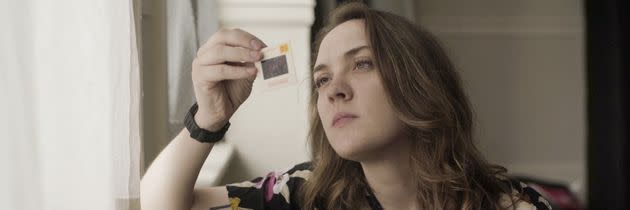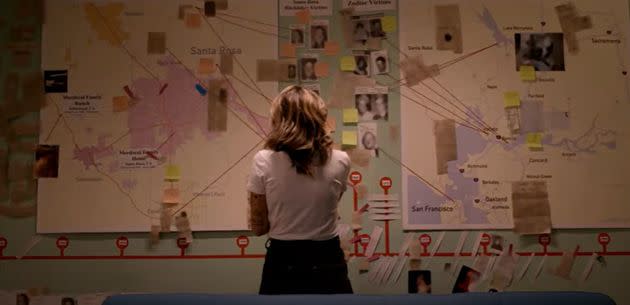2 Women Dig Into Their Families' Dark Pasts In 2 New True Crime Documentaries
This is an excerpt from our true crime newsletter, Suspicious Circumstances, which sends the biggest unsolved mysteries, white-collar scandals and captivating cases straight to your inbox every week. Sign up here.
Two riveting new true crime documentaries streaming on Max feature women looking to expose their family’s dark secrets in search of closure and healing. Coincidentally, the real-life villains in both “Great Photo, Lovely Life” and “The Truth About Jim” are the women’s grandfathers. Their investigations, however, go in very different directions — with one believing her family patriarch was a serial killer.

Amanda Mustard reexamined hundreds of photos and family videos in trying to uncover her family’s secrets and confront their trauma.
“Great Photo, Lovely Life”
In the opening scene of “Great Photo, Lovely Life,” photojournalist Amanda Mustard interviews her grandfather, Bill Flickinger, about his struggles surrounding an unnamed “issue,” while her mom, Debi, sits nervously beside him. He seems like a stereotypical doting grandpa, but his candor is chilling.
“I didn’t want to do things that were bad or wrong,” he says when she asks about his past. “It seemed so strange because there were times … it seemed like some of these little girls would almost throw themselves at me. That might sound a little stupid, but they wanted to learn things, and they were experimental. … To me, it was too much of an open temptation.”
It’s a gasp-eliciting moment, one of many jolts in this extraordinary documentary about intergenerational trauma and the secrets Mustard’s family kept about Flickinger, a chiropractor who sexually assaulted young girls.
Almost as horrific as his abuse is Flickinger’s victim-blaming. When he talks about one girl, presumably the one he eventually served a brief prison stint for sexually assaulting, he says, “Even though she was little … she loved it.”
“Great Photo, Lovely Life” is named for the caption written on the back of a family photo — among hundreds Mustard reexamined, along with old family videos — while trying to uncover her family’s secrets. During her eight years of filming with co-director and cinematographer Rachel Beth Anderson, Mustard reached out to other potential victims of her grandfather. In the documentary, she even goes to the practice where he used to work, with a woman named Bonnie, who says she was victimized as a patient there and elsewhere.
During their visit, they meet the owners of the clinic, devout Christians who emphasize the importance of forgiveness.
“It’s hard to forgive someone who doesn’t ask for forgiveness or think that they did anything wrong,” Bonnie tells them.
Asked how she feels afterward, Bonnie simply replies, “Sick.”
In another scene, Mustard asks her grandfather if he feels like God has forgiven him.
“Absolutely, because there’s no sin that can’t be forgiven, except blasphemy of the Holy Spirit,” he responds. “You can be forgiven no matter what you’ve done.”
Themes of forgiveness, forgetting and denial dominate the intimate conversations — and silences — in “Great Photo, Lovely Life.” We learn that Debi was also abused by Flickinger, as was Mustard’s much older half-sister, Angie. But the difference in how they dealt with their trauma is stark.
In a pivotal moment in the film, Debi is forced to confront the role she played in Angie’s abuse. Even though Debi’s relationship with her daughters becomes fractured, and Flickinger dies without seeing any more criminal consequences, “Great Photo, Lovely Life” ends on a hopeful note.
Healing doesn’t necessarily rely on forgiveness, but forgetting — and allowing smiling family photos to hide a darker truth — makes it possible for the cycle of abuse to continue.

Sierra Barter investigates whether her step-grandfather might have been a serial killer in "The Truth About Jim."
“The Truth About Jim”
“His name was Jim Mordecai, and he was a very bad man,” Sierra Barter says about her step-grandfather in the opening of “The Truth About Jim.”
Just how bad is what Barter sets out to determine in the new docuseries by iconic true crime filmmaker Skye Borgman (“Abducted in Plain Sight,” “Girl in the Picture”). In addition to Mordecai’s history of sexual assault, Barter thinks he might have been a serial killer.
“The Truth About Jim” documents Barter’s extensive two-year investigation — assisted by her mother, Shannon, and grandmother, Judy — into Mordecai’s past.
Unlike Mustard in “Great Photo, Lovely Life,” Barter never had the opportunity to question her step-grandfather directly. He died of cancer in 2008, and she didn’t know him growing up because Shannon was estranged from her mother for most of Judy’s 20-year marriage to Mordecai.
Barter’s quest for answers, which ultimately sees her mother and grandmother reconcile, is rooted in her own history of sexual assault, she says in the docuseries. She was raped twice and feels a connection to the culture of blaming and shaming victims that enabled Mordecai, a beloved high school teacher and coach, to prey upon his students.
Barter interviewed a number of women who said that Mordecai sexually assaulted them, as well as some who were able to escape his advances. She grew increasingly alarmed by the coincidences she found between Mordecai’s past and the early 1970s Santa Rosa hitchhiker murders — the unsolved serial killings of at least seven girls and women in the region where Mordecai grew up.
Based on what Barter uncovered about Mordecai — his history of sexual assault, violence, specific threats, numerous weapons, religiosity and even a box containing pieces of jewelry that could be interpreted as a serial killer’s “souvenirs” — it isn’t difficult for her to believe that Mordecai was capable of murder. What Barter uncovers even leads her to consider that he might have also been the Zodiac Killer, whose victims were also found in Northern California.
With the help of a private investigator and other experts, Barter assembled a mountain of circumstantial evidence, including maps, a giant binder full of numbered exhibits, eyewitness accounts and even Mordecai’s DNA profile, which she obtained from a lab.
Without spoiling the results of her investigation, it becomes clear that experts and authorities appreciated the stark contrast between Barter’s extensive research and that of other amateur sleuths.
Like “Great Photo, Lovely Life,” “The Truth About Jim” is a story about a family’s reckoning with a patriarch’s devastating abuse. Neither Barter nor Mustard were victims of the men whose secrets they sought to expose, but their efforts brought a form of closure to their loved ones.
Barter shared the results of her investigation at a small family reunion in the docuseries’ last episode, telling her mother and several step-siblings: “Thank you for having the courage to make the world better for me, so that I didn’t have to go through what all of you went through.”
“Great Photo, Lovely Life” is currently streaming on Max. All four episodes of “The Truth About Jim” premiere Feb. 15 on Max.
Need help? Visit RAINN’s National Sexual Assault Online Hotline or the National Sexual Violence Resource Center’s website.
